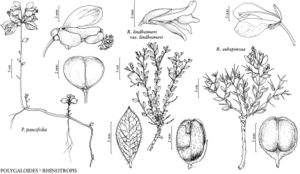Rhinotropis lindheimeri var. lindheimeri
Treatment appears in FNA Volume 10.
Revision as of 10:32, 9 May 2022 by imported>Volume Importer
Stems usually pubescent, rarely glabrous, hairs strictly or irregularly spreading, rarely ± crisped, sparse to dense, mostly 0.3–0.5 mm. Leaf blades elliptic, ovate, or obovate proximally, becoming narrowly so to nearly lanceolate distally, mostly 7–20(–27) × 3–10(–18) mm, venation usually prominently and firmly reticulate, occasionally obscure, surfaces with pubescence similar to stems, or hairs slightly longer. Keel sacs glabrous or with scattered, spreading hairs proximally, hairs not incurved in distal 1/2. 2n = 18.
Phenology: Flowering spring–fall (year-round).
Habitat: Limestone or caliche, sandstone, shale, infrequently on gypsum, granite, or igneous substrates on ridge tops, slopes, roadcuts, canyons in juniper-oak woodlands, grassland, thorn scrub, desert scrub, canyon brush.
Elevation: 90–1600 m.
Distribution
Tex., Mexico (Chihuahua, Coahuila, Durango, Nuevo León, Tamaulipas).
Discussion
Variety lindheimeri occurs in central, southern, and southwestern Texas in over 25 counties.
Selected References
None.
Lower Taxa
None.
... more about "Rhinotropis lindheimeri var. lindheimeri"
Limestone or caliche, sandstone, shale, infrequently on gypsum, granite, or igneous substrates on ridge tops, slopes, roadcuts, canyons in juniper-oak woodlands, grassland, thorn scrub, desert scrub, canyon brush. +
Present +
J. Bot. Res. Inst. Texas +
2011 +
Rhinotropis lindheimeri var. lindheimeri +
Rhinotropis lindheimeri +
variety +
